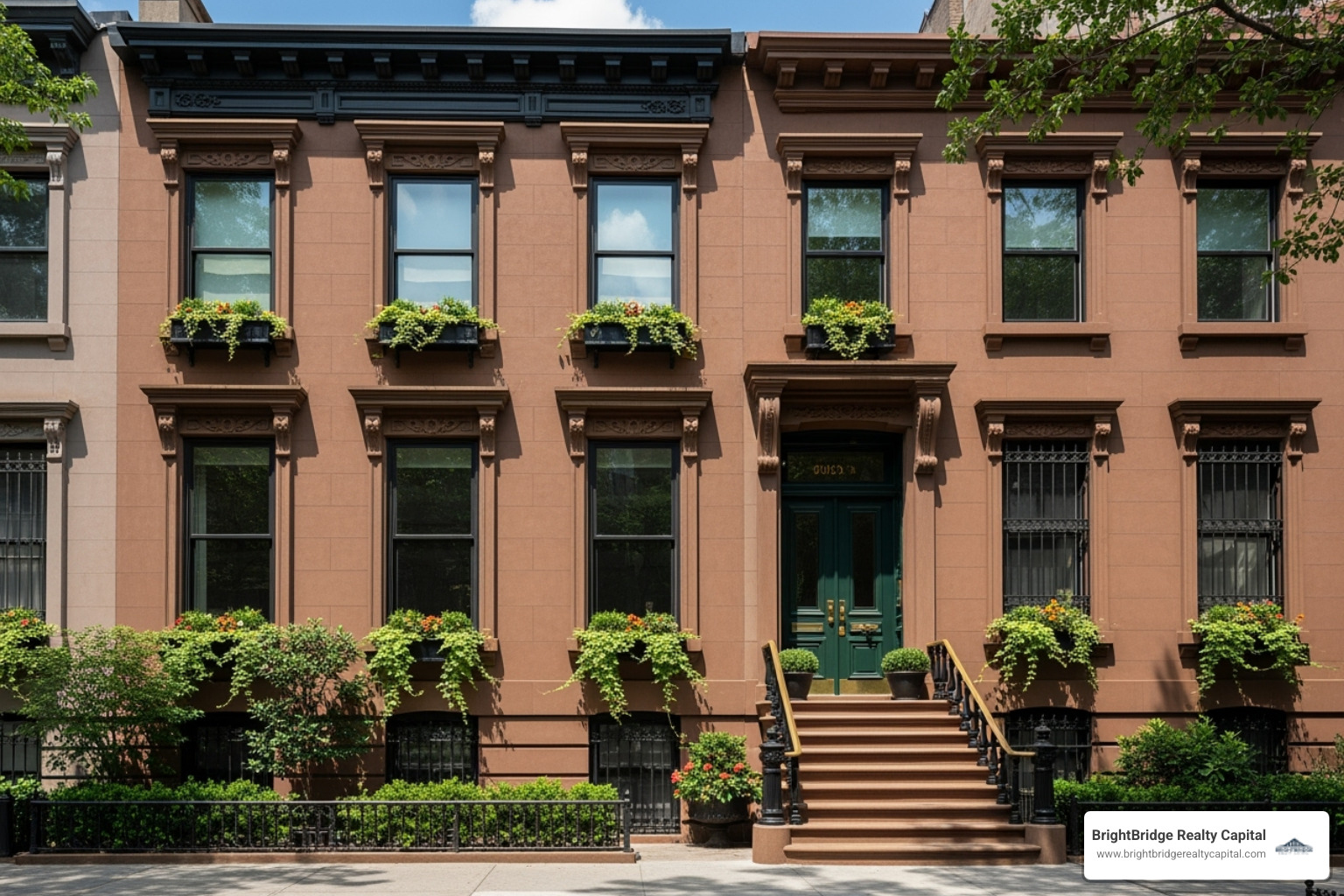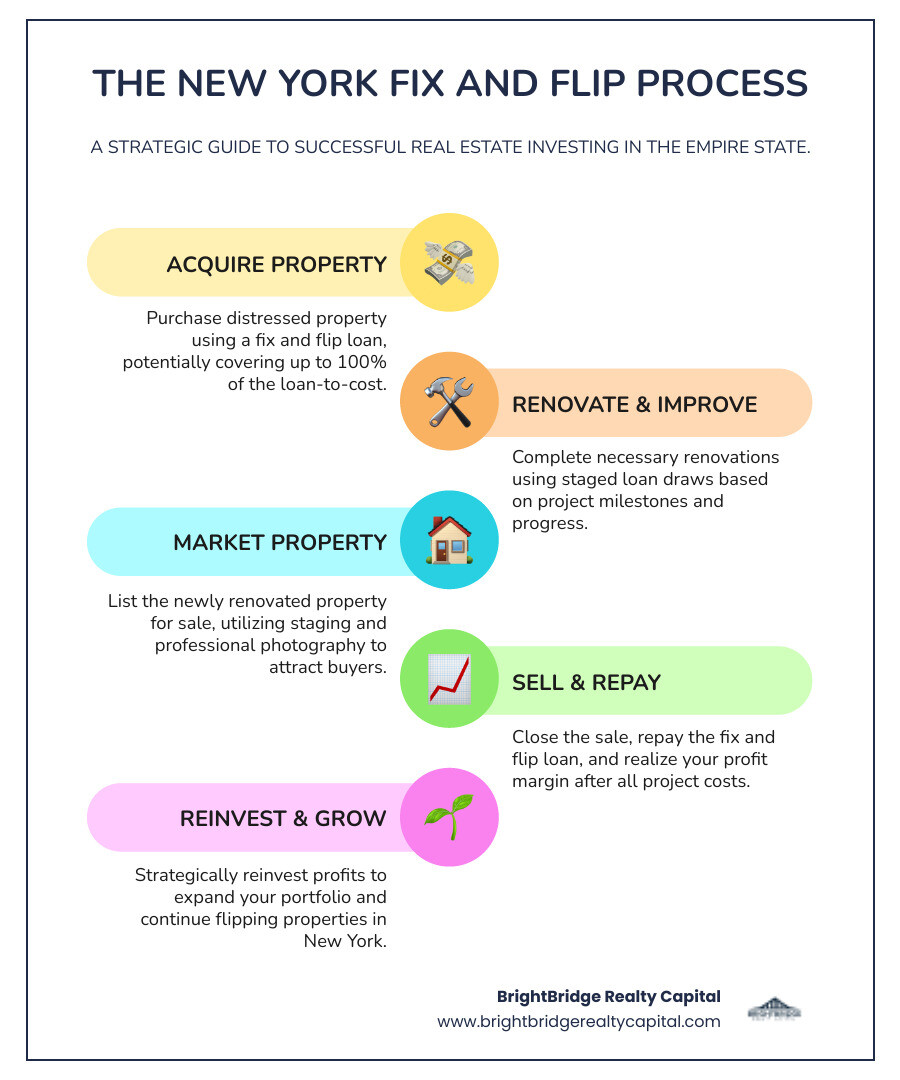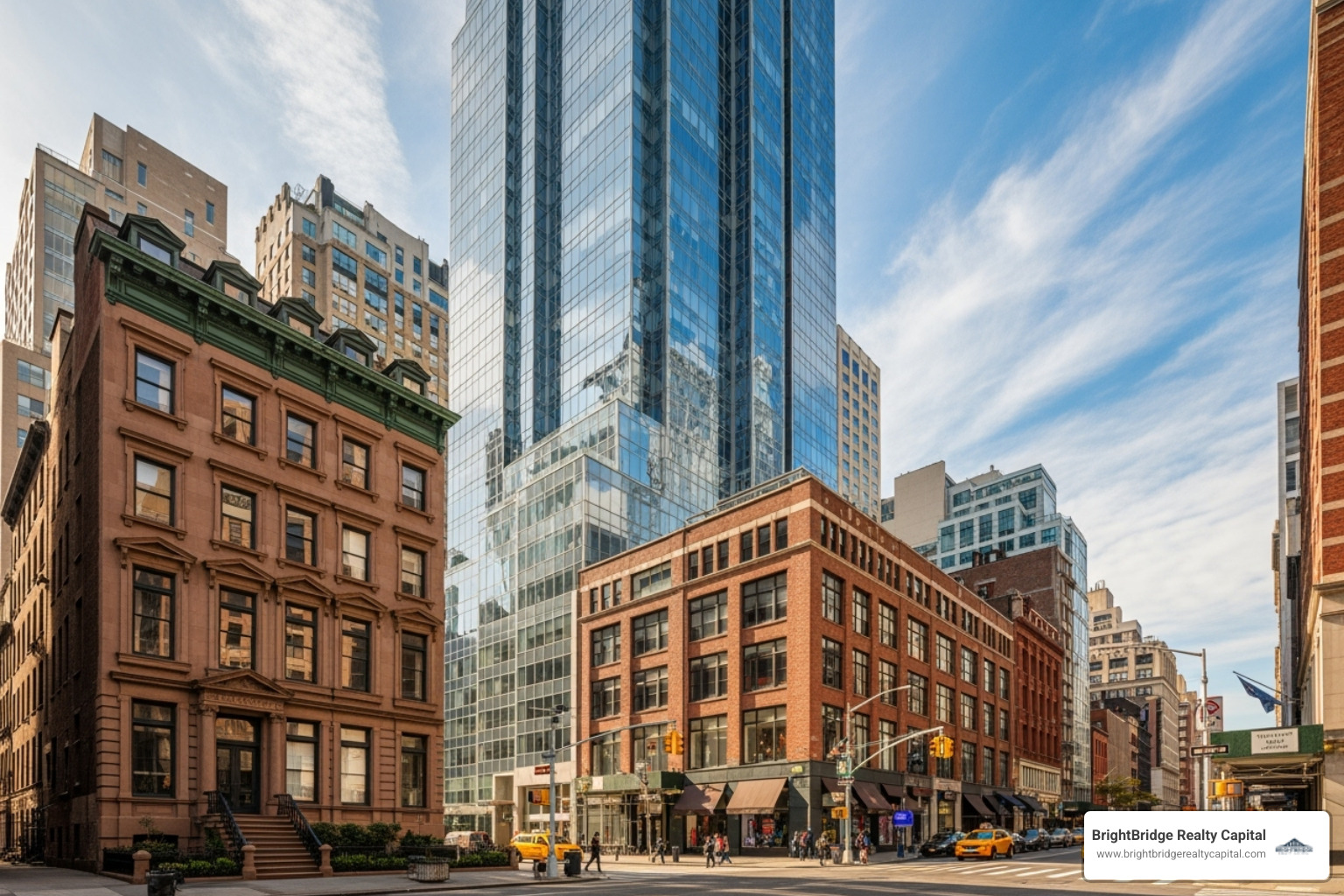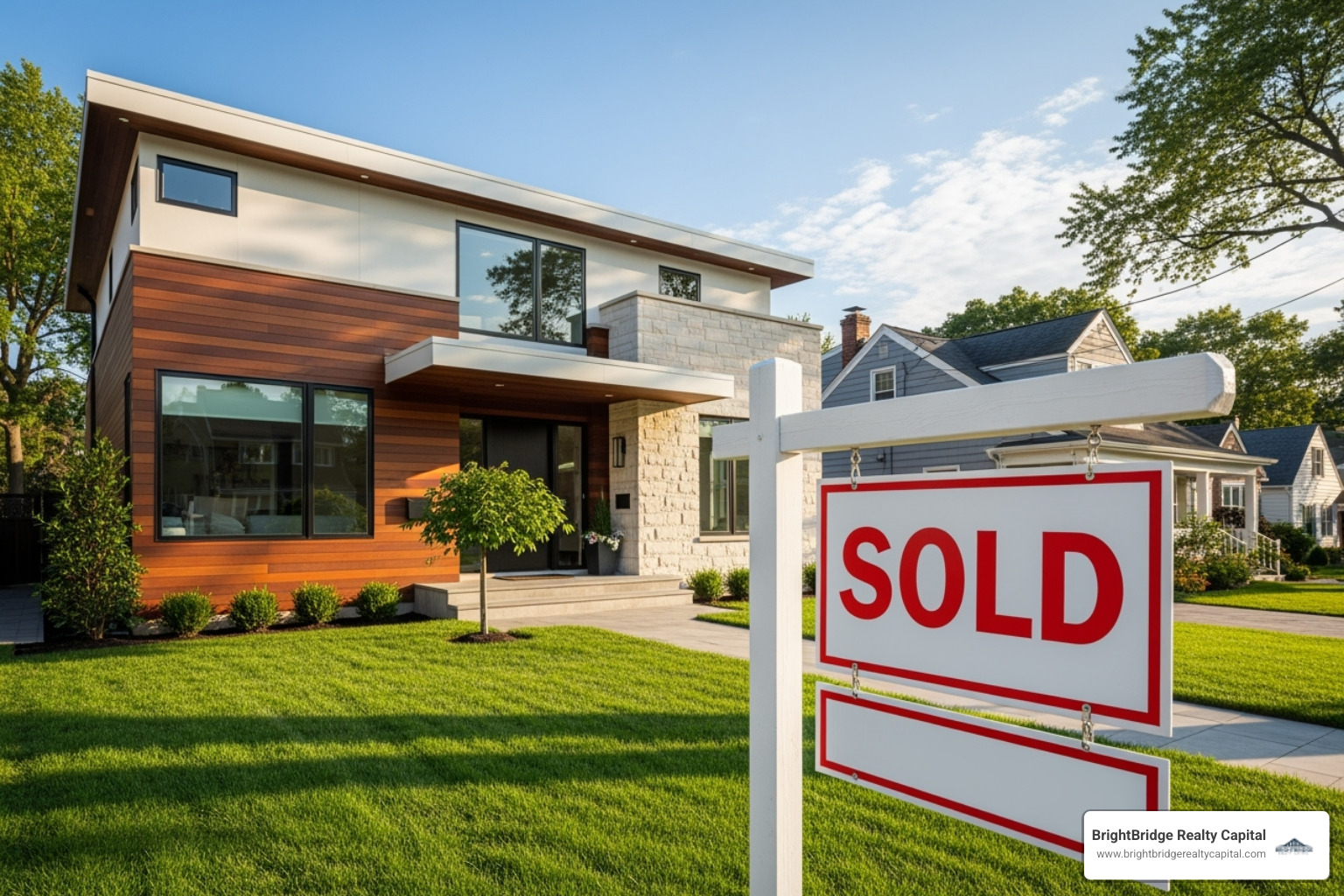Get Your Fix: Navigating New York Fix and Flip Loans

Why New York Fix and Flip Financing Demands a Strategic Approach
Fix and flip loan New York options are essential for real estate investors looking to capitalize on one of the nation's most dynamic property markets. To succeed, you need the right financing to purchase, renovate, and resell properties quickly.
Quick Stats: The average fix and flip loan in New York is $317,220 at 11.2% interest for 24 months, with a median loan-to-value of 72%.
New York's real estate market offers incredible opportunities, with an average gross profit per flip of $97,000. From Brooklyn brownstones to Buffalo revivals, the state has diverse properties with strong potential. However, speed matters in this competitive environment, and traditional bank financing can't keep pace.
That's where specialized fix and flip loans come in. These short-term, asset-based loans focus on the property's potential value after repairs (ARV), not just your credit history. They can cover up to 100% of renovation costs and close in as little as 7 days, giving you the edge to secure properties before other buyers. Success also requires navigating high labor and material costs and significant property taxes in cities like Rochester (2.45%) and Buffalo (1.91%).
I'm Daniel Lopez, a loan officer at BrightBridge Realty Capital, where I've helped numerous investors structure fix and flip loan New York deals that accommodate tight timelines and competitive conditions. Whether it's your first flip or you're expanding your portfolio, the right lender makes all the difference.

Simple fix and flip loan New York glossary:
Understanding the Landscape of Fix and Flip Loans in New York
When exploring fix and flip loan New York options, you'll find they are specialized tools for investors who need to move fast, unlike traditional 30-year mortgages.

Think of fix and flip loans as the sprint of real estate financing. While traditional mortgages focus heavily on your personal finances (credit score, job history), fix and flip loans focus on the asset itself—the property and its potential value after renovation. This asset-based approach allows for much faster underwriting, with closings in weeks instead of months. In New York's market, this speed is a critical advantage.
These loans have short terms, typically 12 to 24 months, with interest-only payments during the loan term to help manage cash flow during renovations. The average interest rate for a fix and flip loan New York is around 11.2%, with origination fees averaging 2.9%. While higher than traditional rates, this reflects the speed, flexibility, and ability to finance properties that banks won't. The average loan amount of $317,220 shows these loans can fund a wide range of projects.
Key Financial Metrics: LTV, LTC, and ARV
Understanding these three metrics is key to structuring your deal:
Loan-to-Value (LTV) measures the loan against the property's current market value. With a median LTV of 72% in New York, a property worth $200,000 might secure a loan of around $144,000 based on LTV.
Loan-to-Cost (LTC) considers your total project cost (purchase price plus renovation budget). Lenders may finance up to 90% or even 100% of your total costs, which is a game-changer for preserving capital.
After-Repair Value (ARV) is the most critical number: the estimated value of your property after renovations. Lenders determine ARV by analyzing comparable sales (comps) of similar, recently sold properties in the neighborhood. Solid comps are essential to ensure the project is financially viable for both you and the lender.
Eligible Property Types in the Empire State
Fix and flip loan New York financing covers a wide variety of non-owner occupied residential investment properties. This means you plan to renovate and sell (or rent) the property, not live in it.
Commonly financed properties include:
- Single-family residences (SFRs)
- 2-4 unit properties (duplexes, triplexes, four-plexes)
- Townhomes and condos, especially in denser urban areas
- Brownstones and other historic properties unique to New York
The key requirement is that the property must be for investment purposes. This distinction enables the faster, asset-based underwriting that makes these loans so effective.
For more information about property-related financing options, you might find resources from the Association of Builders and Owners of Greater New York helpful as you steer the New York real estate landscape.
How to Qualify for a Fix and Flip Loan in New York
Getting approved for a fix and flip loan New York is different from a traditional bank loan. Private lenders like us at BrightBridge Realty Capital focus primarily on one question: does this project make sense?

We want to see a clear path to profit, meaning a property with strong after-repair value, a realistic budget, and a solid exit strategy. The property itself is the collateral, so underwriting centers on the asset's viability. Closing your loan in an entity, like an LLC, can be advantageous, shifting the focus from your personal credit to the deal's potential. Lenders also evaluate your liquidity (cash reserves) to ensure you can cover unexpected costs or delays.
| Investor Profile | Typical Requirements |
|---|---|
| New Investor | - Strong deal viability (high ARV potential) - Detailed business plan and Scope of Work - Sufficient liquidity (down payment, reserves) - May require higher down payment or co-signer - Less emphasis on credit score if closing in entity |
| Experienced Investor | - Proven track record of successful flips - Detailed business plan and Scope of Work - Sufficient liquidity (down payment, reserves) - May qualify for better rates, terms, and higher leverage - Existing relationship with lender is a plus |
What are the Eligibility Requirements for a Fix and Flip Loan New York?
Let's break down what we look for when you apply for a fix and flip loan New York.
Your credit score matters, but perhaps less than you think, especially if you close in an LLC. A solid deal can overcome limited credit history. While experienced investors with a proven track record may get better terms, we've funded many first-time flippers who present a compelling deal.
What matters more than experience is a solid business plan and a detailed Scope of Work (SOW). Your SOW should outline specific renovations, costs, and timelines. Your business plan should tell the story: how you found the property, why it's undervalued, what improvements will add value, and your exit strategy, supported by comparable sales data. This shows you're approaching the project as a business.
Navigating Common Pitfalls in the NY Market
New York's market has unique challenges. Here are the most common mistakes and how to avoid them.
The biggest budget-killer is underestimating renovation costs. Labor and materials in New York are expensive. Always get multiple contractor estimates and add a contingency budget of 10-15% for surprises.
New York is a collection of distinct submarkets. Research your specific neighborhood's recent sales, days on market, and buyer preferences. What sells in Williamsburg differs from what sells in Buffalo.
Don't forget holding costs—property taxes, insurance, utilities, and loan interest. New York's property taxes are among the nation's highest (e.g., Rochester at 2.45%). Delays can quickly erode profits. Build conservative assumptions into your numbers to protect your margin.
For more guidance on navigating New York's real estate landscape, check out the Associated Builders & Owners of Greater New York.
From Application to Closing: The Lending Process in NY
Investors love the speed of private lending for fix and flip loan New York projects. When a great property hits the market, you need to move fast, and our process is designed for that.

The application focuses on the property and your plan: its condition, purchase price, renovation budget (with a detailed Scope of Work), and projected After-Repair Value (ARV). Our streamlined underwriting views the deal through an investor's lens, asking if the project is financially sound. We assess the ARV by analyzing comparable sales in the neighborhood, ensuring a viable path to profit.
The timeline from application to closing averages 2-3 weeks, but can be as fast as 7-10 days. This speed is crucial in New York's competitive market, where a fast, certain close can win a deal even against a slightly higher offer contingent on slow bank approvals.
Strategic Financing: Maximizing Your Fix and Flip Loan
Getting approved is just the start; strategic use of the loan is key. Renovation funds are released in stages called draws. You complete a phase of work (e.g., demolition, framing), and after inspection, we release the next draw.
This system helps you succeed. It keeps your project on track and on budget, as funding is tied to progress. It also helps you manage cash flow. Combined with interest-only payments during the renovation, your monthly obligation is lower, as you only pay interest on the funds you've drawn. This frees up capital and gives you breathing room to focus on the renovation, saving you thousands in holding costs.
How New York Market Trends Influence Your Loan
New York is a collection of distinct markets, and understanding neighborhood dynamics is essential for your success and our underwriting. A $200,000 renovation might be perfect for a historic home in one area but completely wrong for another. We consider this specific context when assessing your fix and flip loan New York application.
Local regulations also add complexity. Building codes, permits, and inspection processes vary by municipality. Historic districts often have preservation rules that affect renovation plans and costs. Ignoring these can lead to stop-work orders and fines. We recommend working with local contractors who understand the landscape to avoid costly delays.
For investors focusing on specific regions, local associations like the Buffalo Niagara Builders Association and Rochester Home Builders Association offer valuable insights and networking opportunities.
Frequently Asked Questions about New York Fix and Flip Loans
We talk to investors every day about fix and flip loan New York options. Here are answers to the most common questions.
How quickly can I close on a fix and flip loan in New York?
In New York's competitive market, speed is everything. With direct private lenders like BrightBridge Realty Capital, we move much faster than traditional banks. We often close fix and flip loan New York projects in 2-3 weeks, and some deals can be funded in just a few days. This speed is a major competitive advantage, allowing you to compete with cash buyers and secure properties quickly.
Can I get financing with no fix and flip experience in New York?
Absolutely. Many lenders, including us, work with first-time flippers. These asset-based loans are secured by the property's potential value (its ARV), not your resume. What matters more than experience is a strong deal and a detailed plan. If you've done your homework on comps, have a realistic Scope of Work (SOW), and a clear strategy, you can get funded. Closing in an LLC can also make personal credit history less of a factor.
How much of the renovation costs can be financed with a fix and flip loan New York?
This is a key benefit of fix and flip loan New York financing: you can often finance up to 100% of your rehab budget. This allows you to preserve your capital for other project costs or your next deal. Funds are released in stages, or "draws," as you complete renovation milestones. This draw structure keeps your project on budget and schedule, helps manage cash flow, and gives everyone confidence that work is progressing as planned.
Choosing Your Lending Partner and Starting Your NY Project
Your choice of lending partner can make or break your fix and flip loan New York venture. You need a true partner who understands the New York market and can move at the speed your deals demand.
What separates a great lender from an average one?
- Speed and Agility: A lender who can approve your loan and close quickly is essential in New York's market.
- Direct Lending Model: Working directly with the lender cuts out middlemen, saving time and money while ensuring a smoother process.
- Flexible and Transparent Terms: Look for clear, upfront information on rates, fees, and draw schedules with no hidden surprises.
- Tech-Enabled Platforms: Modern technology streamlines applications and underwriting, saving you time and keeping you informed.
- Expert Support: Invaluable guidance from people who know the New York market can help you avoid pitfalls and maximize your success.
At BrightBridge Realty Capital, we've built our reputation on understanding what fix and flip loan New York investors need. We specialize in quick, flexible funding with fast closings, often within a week. As a direct lender, we offer competitive rates and a seamless process. We provide customized real estate financing solutions nationwide with deep expertise in New York's unique market dynamics.
Whether you're renovating your first Brooklyn brownstone or expanding your portfolio, we're here to support your success. Our team understands the tight timelines and high stakes of flipping properties in the Empire State.
Ready to turn your next distressed property into a profitable venture? Don't let financing slow you down. Start your New York fix and flip project today with BrightBridge Realty Capital.


